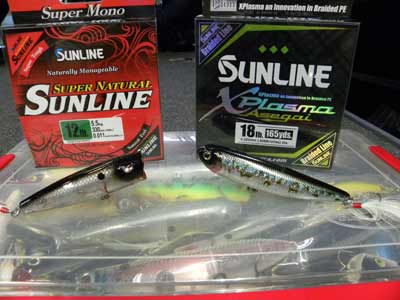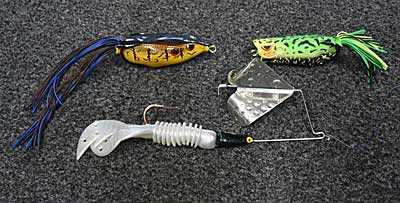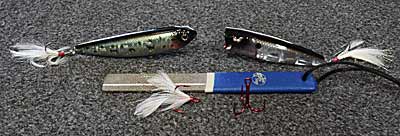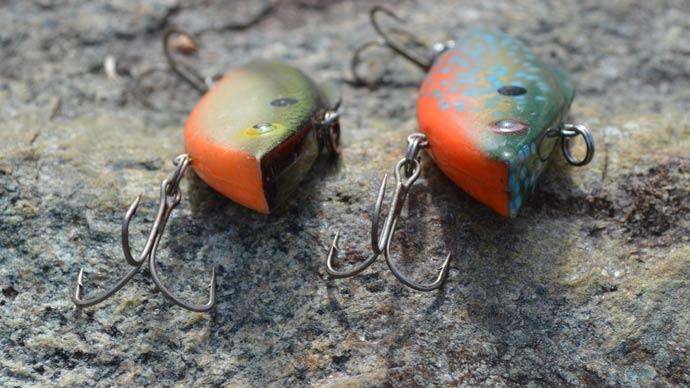
Looking at the fall bass season, you wouldn't think fishing a topwater would be at the top of the list for tactics. But taking a closer look at it, that is where it lands for a few different reasons. Most of this is related to forage that the bass target day in and day out to survive. If you live in the Southern part of the country, the day-to-day shad that the bass feed upon are making movements towards the shallows to eat and spawn. I live in the Upper Midwest, so the day-to-day forage that the bass target up here is bluegills. These bluegills will start to move shallower to prepare for the upcoming seasonal change to winter.
Bluegills will move shallower from their deep-water summer haunts and take the bass right with them, which is logical if they want to eat. The other big reason for this bass movement towards the shallows is the frog migrations during the Fall. Frogs will start to get ready for winter and make movements back toward the waterways. The bass will be right there waiting for them. So, let’s take a closer look at this fall-time topwater action, along with the how’s and what you will need to get ready.
Topwaters To Have On Hand
Blade baits – Buzzbait, Whopper Plopper, and Bladed Zara Spook
Topwater – Zara Spook, and Chug Bug
Frog Baits – SPRO Bronzeye Frog and Bronzeye Popper
Blades - Buzzbaits
Buzzbaits of all the topwater baits will allow you to cover water the fastest. So keep that in mind, as it's critical when you're looking for bass when they start to move back towards the shallows. Today’s buzzbaits are not the same that you were throwing, let’s say, three years ago. Today’s buzzbaits have gone through a transformation. You can use the same buzzer you have before, but what has changed is being put on the bait. Many fishermen are taking off the skirt in favor of putting on a frog, craw, or swimbait in its place. This change does a few different things. First, it gives the bass a bigger profile in the water to target. This alone is creating a better hook-up ratio, and fewer missed strikes. Second, you can slow down your retrieve, helping the bass zero in on the bait better. Make this change and see how it affects your buzzbait fishing this fall.
Blades – Whopper Ploppers
What do I have to say about the Whopper Plopper? It has put topwater fishing back on the charts again. Topwater fishing was pigeonholed to be only fished during certain times of the year, but that is not true anymore, as it's now thought of as a tactic that can be fished all season long in some cases. Example: the Whopper Plopper helped Nick LeBurn earn a win on the BASS Central Open on Grand Lake. The Whopper Plopper is a unique topwater as you just cast it out and start to reel the bait in and hold on.

A few points to remember: Vary your retrieve - I have had days when a stop-and-go retrieve worked best, or use a pull retrieve. Make your cast - let the bait settle and give the rod a pull sideways, just like you're dragging a jig along the bottom. You're dragging the Whopper Plopper across the surface; stop for a count to 3 or 5, reel in the slack, then make another pull.
Another retrieve is to slow crawl or burn the bait across the surface. As you can see, the retrieve patterns you can use are wide open. Keep an open mind and try different retrieves throughout your day until you find what works and triggers bites.
For this tactic, beef up your topwater equipment a little. I'm using a 7’3” or 7’6” MH baitcaster rod that is teamed with a baitcasting reel that is spooled with 30lb braided line. My braid of choice is Sunline Xplasma Asegai. If you're afraid of line-wary bass, use a fluorocarbon leader. I would use a 20lb Sunline Super Natural leader as my line choice.
Bladed Zara Spook
Buried in the Zara Spook bait lineup is one that has props (blades) front and back. I use this bait when I try to get the bass up out of the cover or fish in dirty colored water where it's hard for them to see the bait. The blades create sound and commotion to help the bass find my bait.
Use all the regular retrieves you have been using with this bait, except I'll add a straight pull/jerk and stop retrieve. This sputters the bait forward, and then the stops help the bass zero in on the bait to strike.
When fishing this bait, you will have two line choices: straight mono, or if you want to use braid, you will have to use a mono or FC leader. If you try to use a straight braid, the bait will get tangled in the line when you're walking the bait. I often use braid with a leader as it's easier to give the bait more action with less fishing effort, plus the added benefit of a good solid hookset.
Topwater - Chug Bug & Zara Spook
In my opinion, you can't beat these two choices. There will be days that the bass will prefer one over the other, so carry a handful of topwater baits with you when you hit the water.

I will again vary the rod system I use to fish these two baits. For the Chug Bug, I'll use a 7ft medium action baitcaster teamed with a reel spooled with 30lb Sunline XPlasma Asegai with a 3- to 4-foot 20 lb Sunline Super Natural leader. If you use straight braid, you will get tangled because the straight braid line is so limp that the bait will get caught up in the line.
I use a 7ft to 7’3” MH action rod for the Zara Spook. You're going from a 3/8oz bait with the Chug Bug to a 7/8oz bait with the Zara Spook, so I use a heavier rod to compensate for the larger bait. I'll also use the same line and leader for this bait.
You will have to change things up a little when retrieving. Start with your regular retrieve and see if you can get bites. If not, speed up your offering and change the cadence. As a last option, slow the bait down use more of a twitch-and-glide retrieve with a long pause before the next pull or twitch.
I'm targeting points and flat areas over and on the deeper weed edges when fishing these baits. What I'm trying to do here is look for signs of bass. Topwater that day may not come out to be my main bait, but I use it to show me signs of bass and then start to work the area with other baits.
Frogs And Poppers
The fall frog migration is what is going to drive this segment. Fall time is when the frogs will start to make movements back to the waterways to hibernate for the winter months, so don't be too quick to put your frog and poppers baits away. Concentrate on open pockets up in the pads with your frogs, and throw a popper on the outside edges and in areas with an open area between the shore and the inside edge of the pads. This is where the popper will be worth its weight in gold.
At this time of the season, vary your retrieves and always have a backup bait within reach for missed strikes that you can't get to commit with a follow-up pass with the frog or the popper.
Bait Modifications

There are two points that I want to talk about, red trebles and feathered trebles. These are both key when fishing topwater during the fall period. First, let’s start with red trebles. Change out your front hook to a red treble. The bass is a predator looking to strike. With a red treble rigged on the front of your topwater bait, as the bass is coming up on the bait, the red treble will become the focal point of that bass. This late-season hook tweak will cause the bass to aim and strike at the head of the bait. Adding the red treble to the front of your bait will trigger more strikes and hookups instead of misses, resulting in more bass in your boat during the fall period.
The last point I want to make is to change the back hook to a feather or tinsel treble hook. If you can get a bass to come up and look at your bait, sometimes you will need another trigger attraction to get the bass to make that final commitment and strike. I have had many days a back-dressed treble was the trigger that got the bass to bite. As the bass come up on the bait, they would hold off a little. But that slight movement from the material on the dressed treble as the bait moved and sat was what got the bass to swing at the bait and get hooked up.
So, this Fall, don't rule out topwater baits and tactics. As you can see, things are happening during the Fall period that makes topwater still a great way to get the bass's attention and trigger bites.
BassResource may receive a portion of revenues if you purchase using a link above.




